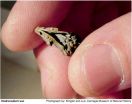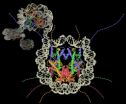(Press-News.org) Pittsburgh, Pennsylvania… Paleontologists have often wondered why mammals—including humans—evolved to have larger brains than other animals. A team of paleontologists now believe that large brains may have developed in mammals to facilitate an acute sense of smell, according to a new paper published today in the prestigious journal Science. The team also noticed enlargement in the areas of the brain that correspond to the ability to sense touch through fur; this sense is acutely developed in mammals.
Scientists used high-resolution CT scans to study rare 190-million-year-old fossil skulls of Morganucodon and Hadrocodium, two of the earliest known mammal species. The research team of Timothy Rowe (University of Texas at Austin), Thomas Macrini (St. Mary's University of Texas), and Zhe-Xi Luo (Carnegie Museum of Natural History) discovered that these tiny mammals from the Jurassic fossil beds of China had much larger brains than expected for specimens of their period. Carnegie paleontologist Luo and his colleagues were the first to discover Hadrocodium, a tiny early Jurassic age mammal that weighed just two grams. Luo noticed that this animal had a very large cranium compared to its tiny body mass, and named it accordingly ("Hadro" being Latin for "fullness"; codium for "head").
"Our new study shows clearly that the olfactory part of the brain and the part of the brain linked to tactile sensation through fur were enlarged in these early mammals," says Luo. "A sophisticated sense of smell and touch would have been crucial for mammals to survive and even thrive in the earliest part of our evolutionary history."
Using computed tomography, also known as CT scanning, the team took a series of X-rays, inching along the specimens and then reassembling the images into a single, detailed image of the interior anatomy of the fossils.
"I have spent years studying these fossils, but until they were CT scanned it was impossible to see the internal details unless you were willing to destroy the skulls to look inside," says Luo. "I was absolutely thrilled to see the shape of the brain of our 190-million-year-old relatives."
"This is a great example of technology allowing us to examine classic scientific questions in a new way," says University of Texas at Austin paleontologist Rowe. "We had studied the outside features of these fossils for years but knew that the inside held the answers. Until now, getting to those answers required destructive methods. With high-resolution CT scanning, we can take a good look into the braincase without damaging the precious fossils—we can have our cake and eat it too."
Thomas Macrini of St. Mary's University (Texas), an expert in analyzing interior structures of fossils through CT scanning, was able to construct a virtual cast of the brains of these mammals. These were compared to the team's CT-scan data from more than a dozen other fossils and some 200 mammal species living today. The results were surprising: Even 190 million years ago, the brains of the earliest mammals were notably large (as relative to body mass), with brain-to-body sizes approaching the proportions seen in modern mammals.
From previously discovered fossil evidence, scientists knew that the nasal structure in some early mammals was quite advanced. From the CT scans of Morganucodon and Hadrocodium researchers were able to determine that area of the brain that had grown the largest in these early mammals was the region responsible for the sense of smell. The CT scans of Morganucodon and Hadrocodium also revealed that the area of the brain mapped to tactile sensations from fur was enlarged. Mammals have a uniquely well developed ability to sense touch through their fur. Jurassic mammals such as Hadrocodium are considered by scientists to have had full coats of dense hair.
"Our mammal ancestors didn't develop that larger brain for contemplation, but for the sense of smell and touch. But thanks to these evolutionary advancements, which gave mammals a head start toward developing a large brain, humans some 190 million years later can ponder these very questions of natural history and evolution," said Luo.
INFORMATION:
Carnegie Museum of Natural History, one of the four Carnegie Museums of Pittsburgh, is ranked among the top five natural history museums in the country. It maintains, preserves, and interprets an extraordinary collection of 20 million objects and scientific specimens used to broaden understanding of evolution, conservation, and biodiversity. More information is available by calling 412.622.3131 or by visiting the Web site, www.carnegiemnh.org.
Large brains in mammals first evolved for better sense of smell
Ability to sense touch through fur also a factor
2011-05-20
ELSE PRESS RELEASES FROM THIS DATE:
Death of Osama bin Laden Highlights Importance of the Zadroga Act, Says New York Personal Injury Lawyer
2011-05-20
After the death of Osama bin Laden, New York personal injury lawyer David Perecman reaffirmed his commitment to help the heroes who are still battling illnesses connected to 9/11.
For many individuals, the death of bin Laden brought closure. The death also served to rekindle memories of those who volunteered to assist at the World Trade Center site after the 9/11 attacks.
The lives of many Ground Zero volunteers were changed in challenging ways. Rescue and recovery workers and others are still suffering from health consequences related to the World Trade Center disaster.
"People ...
Scientists discover new drug target for squamous cell carcinoma
2011-05-20
SEATTLE – Researchers at Fred Hutchinson Cancer Research Center have discovered a new drug target for squamous cell carcinoma – the second most common form of skin cancer. Scientists in the laboratory of Valeri Vasioukhin, Ph.D., have found that a protein called alpha-catenin acts as a tumor suppressor and they also have unlocked the mechanism by which this protein controls cell proliferation.
The findings by Vasioukhin and colleagues will be published May 24 in Science Signaling.
For the study, the researchers studied mice that were bred to lack a copy of the gene that ...
Packaging process for genes discovered in new research
2011-05-20
Scientists at Penn State University have achieved a major milestone in the attempt to assemble, in a test tube, entire chromosomes from their component parts. The achievement reveals the process a cell uses to package the basic building blocks of an organism's entire genetic code -- its genome. The evidence provided by early research with the new procedure overturns three previous theories of the genome-packaging process and opens the door to a new era of genome-wide biochemistry research. A paper describing the team's achievement will be published in the journal Science ...
Senators Want DUI Applications Removed From Smartphones
2011-05-20
In March, four Democratic U.S. Senators, Harry Reid, D-Utah, Chuck Schumer, D-N.Y., Frank Lautenberg, D-N.J., and Tom Udall, D-N.M., drafted a letter requesting that Apple, Google and Research in Motion (or RIM) eliminate the applications (user-friendly computer programs for specific tasks) on mobile communication devices that warn drivers of the locations of drunk-driving checkpoints.
The next day, RIM, the manufacturer of the BlackBerry agreed to the removal of driving-under-the-influence (DUI/DWI) checkpoint functionality on its BlackBerry devices.
Google later ...
What Causes the Metal Skin on an Airliner to Tear Apart?
2011-05-20
On Friday, April 1, 2011, a Southwest Airlines Boeing 737-300 experienced a rapid decompression when the metal fuselage skin tore apart, leaving a 5X1 foot hole. This kind of event is rare, but can, and has been, catastrophic when it does occur.
In 1988, another Boeing 737, a 200 model, experienced a similar, but much worse, event over Hawaii. In that case, the skin on the entire front section of the aircraft cabin was denuded, leaving the passengers sitting in the first several rows completely exposed, with the aircraft being held together by two metal spars running ...
Of frogs, chickens and people
2011-05-20
Researchers at the University of California, San Diego School of Medicine have uncovered new details of an unusual biological mechanism in the brains of diverse species that not only helps regulate how their brains develop, but also how they function later in life. The discovery could lead to new biomarkers for specific neurological diseases in humans and, possibly, the development of drugs to cure them.
The research, by Miles F. Wilkinson, PhD, professor of reproductive medicine and a member of the UCSD Institute for Genomic Medicine, and colleagues, is published in ...
Preparing for a Prenuptial Agreement
2011-05-20
Thinking about, let alone preparing for, divorce before you are even married is not what most of us want to do. Whether we believe that divorce will never happen to us or whether we just choose to ignore the possibility, the fact remains that almost half of all marriages in the United States end in divorce.
One way to enter into a marriage prepared for all outcomes is to create a prenuptial agreement. Creating this agreement doesn't mean that your marriage will eventually come to an end. Rather, creating a prenuptial agreement is just a way for you and your spouse to ...
Looking deep into a huge storm on Saturn
2011-05-20
The atmosphere of the planet Saturn normally appears placid and calm. But about once per Saturn year (about thirty Earth years), as spring comes to the northern hemisphere of the giant planet, something stirs deep below the clouds that leads to a dramatic planet-wide disturbance (eso9014 - http://www.eso.org/public/news/eso9014/).
The latest such storm was first detected by the radio and plasma wave science instrument on NASA's Cassini spacecraft [1], in orbit around the planet, and also tracked by amateur astronomers in December 2010. It has now been studied in detail ...
Supreme Court Seems to Give Prosecutors Free Pass to Win at All Costs
2011-05-20
A recent opinion from the U.S. Supreme Court in Connick v. Thompson seems to give prosecutors a free pass to win at all costs. The opinion overlooks a pattern of misconduct by prosecutors in cases against John Thompson, who was almost executed before he was exonerated and set free. Thompson's experience demonstrates the need for capable legal counsel to fight against any prosecutorial misconduct when facing criminal charges.
Connick v. Thompson
In 1984, John Thompson was convicted of armed robbery in Louisiana. In 1985, Thompson was also tried and found guilty of ...
Unmarried Fathers Have Rights, Too
2011-05-20
If you and your child's mother are not married when the child is born, you may feel like a second-class citizen. You probably think that your rights are completely contingent upon the whims of your child's mother. You may be afraid that you could lose the ability to live with or visit your child. Fortunately, though, Michigan laws recognize that you have rights when it comes to your children. The laws make it possible for you to be legally listed as the child's father, to make a claim for custody or visitation and to have the ability to make decisions about how your child ...
LAST 30 PRESS RELEASES:
Nanoplastics have diet-dependent impacts on digestive system health
Brain neuron death occurs throughout life and increases with age, a natural human protein drug may halt neuron death in Alzheimer’s disease
SPIE and CLP announce the recipients of the 2025 Advanced Photonics Young Innovator Award
Lessons from the Caldor Fire’s Christmas Valley ‘Miracle’
Ant societies rose by trading individual protection for collective power
Research reveals how ancient viral DNA shapes early embryonic development
A molecular gatekeeper that controls protein synthesis
New ‘cloaking device’ concept to shield sensitive tech from magnetic fields
Researchers show impact of mountain building and climate change on alpine biodiversity
Study models the transition from Neanderthals to modern humans in Europe
University of Phoenix College of Doctoral Studies releases white paper on AI-driven skilling to reduce burnout and restore worker autonomy
AIs fail at the game of visual “telephone”
The levers for a sustainable food system
Potential changes in US homelessness by ending federal support for housing first programs
Vulnerability of large language models to prompt injection when providing medical advice
Researchers develop new system for high-energy-density, long-life, multi-electron transfer bromine-based flow batteries
Ending federal support for housing first programs could increase U.S. homelessness by 5% in one year, new JAMA study finds
New research uncovers molecular ‘safety switch’ shielding cancers from immune attack
Bacteria resisting viral infection can still sink carbon to ocean floor
Younger biological age may increase depression risk in older women during COVID-19
Bharat Innovates 2026 National Basecamp Showcases India’s Most Promising Deep-Tech Ventures
Here’s what determines whether your income level rises or falls
SCIE indexation achievement: Celebrate with Space: Science & Technology
Children’s Hospital Colorado performs region’s first pediatric heart and liver dual organ transplant
Australian team discover why quantum computers have memory problems over time
What determines the fate of a T cell?
Candida auris: genetic process revealed which could be treatment target for deadly fungal disease
Groundbreaking discovery turns household plastic recycling into anti-cancer medication
Blocking a key inflammatory pathway improves liver structure and vascular function in cirrhosis, study finds
Continuous spread: Raccoon roundworm detected in nine European countries
[Press-News.org] Large brains in mammals first evolved for better sense of smellAbility to sense touch through fur also a factor



